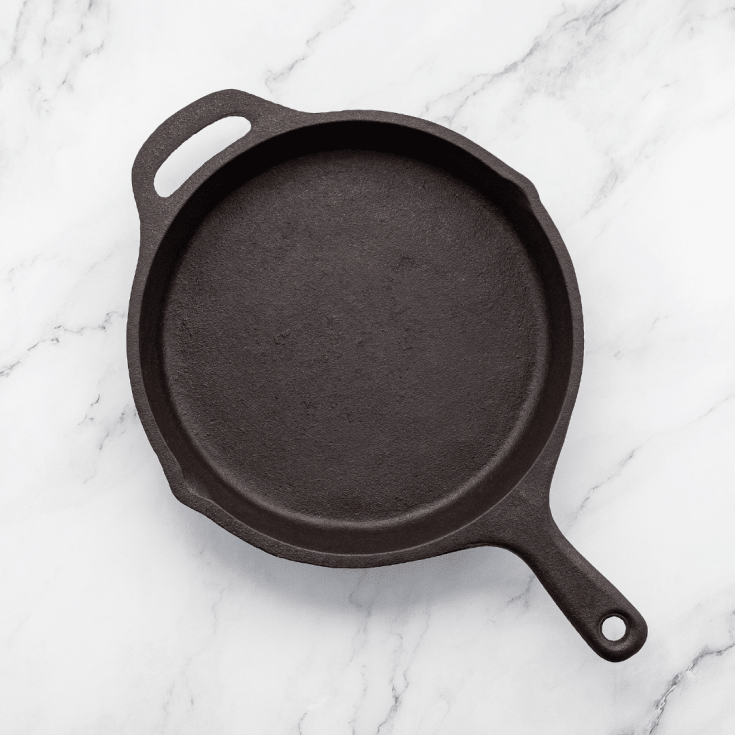The best way to season a cast iron pan the first time and regular maintenance for a perfect reliable nonstick coating.
So the whole care and maintenance of cast iron pans was the number one reason I didn't use one for a long time. Even when I did attempt to use one, I found myself googling, not understanding, and feeling like I was doing it all wrong, both for cleaning and seasoning. But, as many of you have noticed, I have figured it out, and now I exclusively use my cast iron pan (except for eggs), and I'm never going back. After much trial and error, I'm going to break down how I initially seasoned my cast iron pan, how often I season it, and a step-by-step process for seasoning (in a printable card!) Hopefully, after this post, you'll also be a cast iron pan convert who is confident in seasoning their cast iron cookware.
Step 1: Chose the Right Pan
Here is the thing, I had a cast iron pan that was incredibly sticky and hard to care for. I have no idea where it came from or how it came into my possession, but I hated it. My MIL encouraged me to buy a Lodge Pre-Seasoned Cast Iron pan, which rocked my world. Suddenly, I understood why people loved their cast iron pans so much and how they could always cook on them.
So, I have a whole post on the best-cast iron pans (including raw vs. enameled), but for raw cast iron (which requires seasoning), you want to start with a great pre-seasoned layer because that's a heck of a lot easier than starting from scratch. Seasoning builds up over time, getting better and better after each seasoning treatment. If you are starting with no base layer, it's going to feel like an uphill battle. So, my suggestion is to start with a high-quality pre-seasoned pan.
Step 2: Scrub Pan
Whether it's the first time seasoning your pan or part of regular maintenance, you'll want to ensure you start with a clean pan with no residue. I used a steel wool scrubber and hot water to prep my pan for seasoning. I scrub all over the pan, almost like I"m buffing it out. Yes, even for the first time, your season it and even on a pre-seasoned pan. You don't want any chemical residue left over.
PS I learned this tip on Amazon reviews of the Lodge pan after so many people said they had pre-scrubbing the pan in their seasoning workup, I tried it, and it worked really well.
Step 3: Dry Pan
I dry it off with a towel and then place it on the burner on medium-high to completely dry it out. I decide it's dry when it looks dry, probably around 3-5 minutes. No science here, people.
Step 4: Preheat the Oven to 450F.
Rub oil all over the pan, inside and out. Make sure to go back over the pan with a paper towel and buff it out. You don't want excess oil on your pan. This is not a more is a better situation. Excess oil can create a coating that is sticky or not even. Place the pan upside down on the middle rack. Place a foil-lined baking sheet on the bottom shelf to catch any drippings. If you've properly buffed out the oil, you shouldn't have drippings, but just in case. Let the pan bake for 30 minutes.
This will smell not good, so make sure you have fans on and the kitchen is well-ventilated. Also, try not to season your pan when you have sensitive family members or company over. There may be a little smoking, but there should not be excessive smoking (this is why it's essential to use an oil with a high smoke point.)
Step 5: Repeat Step 4 Three Times
I repeat step 4 three times exactly as written, except I only do the reoil on the pan's cooking surface for these times.
Step 6: Let Cool
I just turn off the oven and let it cool in the oven because I store it there (we have two ovens, so I store mine in the bottom oven.)
Frequently Asked Questions
What kind of oil should you use to season your cast iron pan?
I've read so many articles on this. There are many schools of thought about the best oil. The school of thought I subscribe to is that you should use an oil with a high smoke point that you frequently use in your kitchen. So, I use Avocado Oil to season my pan. I've also used canola oil, although I rarely cook with it. It's cheaper than Avocado oil, has a high smoke point and has a good nutrition profile. I like avocado oil for many reasons. Using it to season my cast iron pan makes the most sense and has worked great!
How often should you season your cast iron pan?
I try to do it monthly since I use this pan almost daily. However, I can get away with bi-monthly now that I've built a nice seasoning layer. If I notice it's starting to stick and be more challenging to clean than usual, I try to season it again within that week. For the first six months, though, I was diligent about monthly, which seems to have paid off now.
What about other seasoning methods?
I've tried several other seasoning methods, including the one where you bake the pan once for an hour. I never got as good of results as using the method I described above, but I encourage you to try multiple methods to find what works best for you (I'm guessing it could vary depending on the oven, age of the pan, pre-seasoning layer, etc.)
How to Season A Cast Iron Pan

Materials
Instructions
More About Cast Iron Cooking:







Leave a Reply